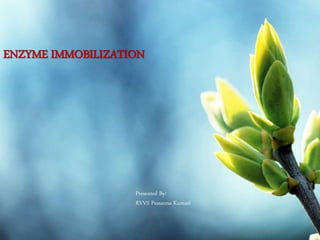
Enzyme immobilization
- 1. ENZYME IMMOBILIZATION Presented By: RVVS Prasanna Kumari
- 2. Topics covered are: 1.Definition of an enzyme 2.Definition of enzyme immobilization 3.Advantages of enzyme immobilisation 4.Definition of carriers & its properties 5.Types of carriers 6.Methods of enzyme immobilisation & their advantages, disadvantages 7.Limitations of enzyme immobilisation 8.Modern techniques
- 3. ENZYME ??? a substance produced by a living organism which acts as a catalyst to bring about a specific biochemical reaction & shows its activity even when it is independent.
- 4. ENZYME IMMOBILISATION??? Enzyme immobilization can be defined as a process where the movement of enzymes in space is completely or severely restricted and which can be used repeatedly and continuously . Immobilized enzymes are also referred as matrix- linked enzymes.
- 5. Advantages of immobilization enzymes….. Enzymes can be reused. Favourable sterile characteristics. Accelerates the chemical reaction. Not difficult to separate. Catalytic operation can be operated continuously.
- 6. CARRIERS….. The substances used for immobilising of enzymes are termed as “carriers”. The form, shape, density, porosity, pore size distribution, operational stability and particle size distribution of the supporting matrix will influence the reactor configuration in which the immobilised biocatalyst may be used.
- 11. PHYSICAL METHODS: Adsorption, ion bonding CHEMICAL METHODS: Covalent bonding,cross linking MECHANICAL METHODS: Entrapment,microencapslation TYPES OF ENZYME IMMOBILIZATION
- 13. ADSORPTION *The adsorption of an enzyme onto a support or film material is the simplest method of obtaining an immobilized enzyme. *The interactions formed between the enzyme and the support material will be dependent on the existing surface chemistry of the support and on the type of amino acids exposed at the surface of the enzyme molecule. • Enzyme immobilization by adsorption involves, normally, weak interactions between the support and the enzyme such as ionic or hydrophobic interactions, hydrogen bonding, and van der Waals forces
- 14. • Most of the support materials available have sufficient surface- charge properties suitable for immobilization by adsorption. They include inorganic carriers (ceramic, alumina, activated carbon, kaolinite, bentonite, porous glass), organic synthetic carriers (nylon, polystyrene), and natural organic carriers (chitosan, dextran, gelatin, cellulose, starch). • The method consists of simply mixing an aqueous Solution of enzyme with the support material for a period of time, after which the excess enzyme is washed away from the immobilized enzyme on the support. • The procedure requires strict control of the pH and ionic strength, because these can alter the charges of the enzyme and the support and therefore affect the level of adsorption.
- 16. IONIC BINDING • Immobilization via ionic binding is based, mainly, on ionic binding of enzyme molecules or active molecule to solid supports containing ionic charges. • In this method, the amount of enzyme bound to the carrier and the activity after immobilization depends on the nature of the carrier. • In some cases, physical adsorption may also take place. The main difference between ionic binding and physical adsorption is the strength of the interaction, which is much stronger for ionic binding • The preparation of immobilized enzymes using ionic binding is based on the same procedure as described for physical adsorption.
- 17. • The ionic nature of the binding forces between the enzyme and the support also depends on pH variations, support charge, enzyme concentrations, and temperature. • The supports used for ionic binding may be based on polysaccharide derivatives (e.g., diethylaminoethylcellulose, dextran, chitosan, carboxymethylcellulose), synthetic polymers (e.g.,polystyrene derivatives, polyethylene vinylalcohol), and inorganic materials (e.g., ambertite, alumina, silicates, bentonite, sepiolite, silica gel, etc.).
- 18. COVALENT BINDING • The covalent binding method is based on the binding of enzymes to a support or matrix by means of covalent bonds. • The bond is normally formed between a functional group present on the support surface and amino acid residues on the surface of the enzyme. Those which are most often involved in covalent binding are the amino (NH2) group of lysine or arginine, carboxyl (CO2H) group of aspartic acid or glutamic acid, hydroxyl (OH) group of serine or threonine, and sulphydryl (SH) group of cysteine.
- 19. • Basically, two steps are involved in the covalent binding of enzymes to a support material. • First, functional groups on the support material are activated by specific reagents (e.g., cyanogen bromide, carbodiimide, aminoalkylethoxysilane, isothiocyanate, and epichlorohydrin, etc.) • Then there are many reaction procedures for joining an enzyme to a material with a covalent bond (diazotation, amino bond, Schiff’s base formation, amidation reactions, thiol-disulfide, peptide bond, and alkylation reactions).
- 22. CROSS LINKING • The crosslinking method is based on the formation of covalent bonds between the enzyme by means of bi- or multifunctional reagents. • The individual enzymes are joined to one another with the help of bi- or multifunctional reagents (e.g., glutardialdehyde, glutaraldehyde, glyoxal, diisocyanates, hexamethylene diisocyanate, toluene diisocyanate, etc.). • Enzyme crosslinking involves normally the amino groups of the lysine but, in occasional cases, the sulfhydryl groups of cysteine, phenolic OH groups of tyrosine, or the imidazol group of histidine can also be used for binding. And also by co-crosslinking, in which inert molecules are incorporated in the high-polymer network in order to improve the mechanical and enzymatic immobilized preparation.
- 24. ENZYME ENTRAPMENT • The entrapment method for immobilization consists of the trapping of enzymes into a film, gel, or fiber • This method can be achieved by mixing an enzyme with a polymer and then crosslinking the polymer to form a lattice structure that traps the enzyme.
- 27. MICRO ENCAPSULATION • Microencapsulation is the physical trappingof enzymes • Microencapsulated enzymes are formed by enclosing enzymes solution within spherical semipermeable polymer membranes with controlled porosity
- 30. NOVEL METHOD OF IMMOBILISING ENZYMES